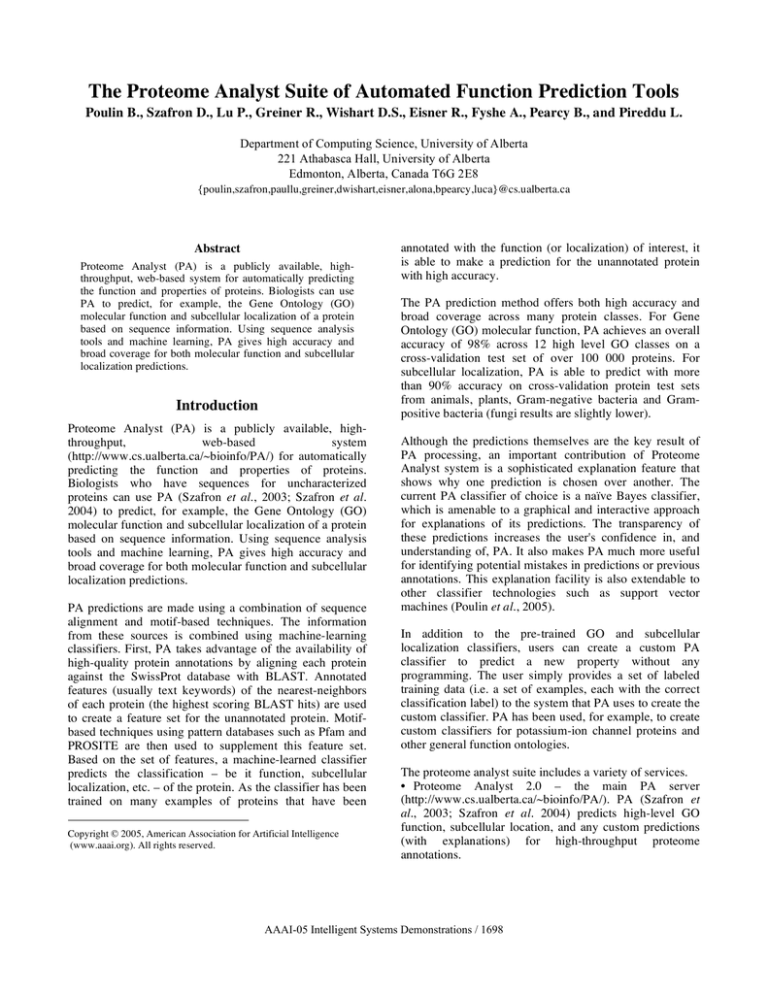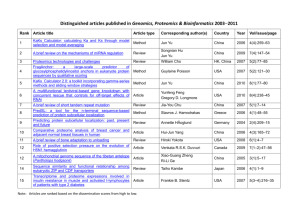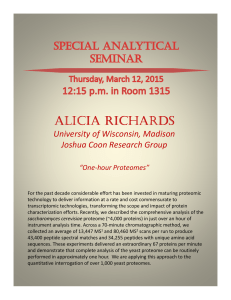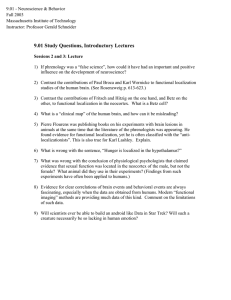The Proteome Analyst Suite of Automated Function Prediction Tools
advertisement

The Proteome Analyst Suite of Automated Function Prediction Tools
Poulin B., Szafron D., Lu P., Greiner R., Wishart D.S., Eisner R., Fyshe A., Pearcy B., and Pireddu L.
Department of Computing Science, University of Alberta
221 Athabasca Hall, University of Alberta
Edmonton, Alberta, Canada T6G 2E8
{poulin,szafron,paullu,greiner,dwishart,eisner,alona,bpearcy,luca}@cs.ualberta.ca
Abstract
Proteome Analyst (PA) is a publicly available, highthroughput, web-based system for automatically predicting
the function and properties of proteins. Biologists can use
PA to predict, for example, the Gene Ontology (GO)
molecular function and subcellular localization of a protein
based on sequence information. Using sequence analysis
tools and machine learning, PA gives high accuracy and
broad coverage for both molecular function and subcellular
localization predictions.
Introduction
Proteome Analyst (PA) is a publicly available, highthroughput,
web-based
system
(http://www.cs.ualberta.ca/~bioinfo/PA/) for automatically
predicting the function and properties of proteins.
Biologists who have sequences for uncharacterized
proteins can use PA (Szafron et al., 2003; Szafron et al.
2004) to predict, for example, the Gene Ontology (GO)
molecular function and subcellular localization of a protein
based on sequence information. Using sequence analysis
tools and machine learning, PA gives high accuracy and
broad coverage for both molecular function and subcellular
localization predictions.
PA predictions are made using a combination of sequence
alignment and motif-based techniques. The information
from these sources is combined using machine-learning
classifiers. First, PA takes advantage of the availability of
high-quality protein annotations by aligning each protein
against the SwissProt database with BLAST. Annotated
features (usually text keywords) of the nearest-neighbors
of each protein (the highest scoring BLAST hits) are used
to create a feature set for the unannotated protein. Motifbased techniques using pattern databases such as Pfam and
PROSITE are then used to supplement this feature set.
Based on the set of features, a machine-learned classifier
predicts the classification – be it function, subcellular
localization, etc. – of the protein. As the classifier has been
trained on many examples of proteins that have been
Copyright © 2005, American Association for Artificial Intelligence
(www.aaai.org). All rights reserved.
annotated with the function (or localization) of interest, it
is able to make a prediction for the unannotated protein
with high accuracy.
The PA prediction method offers both high accuracy and
broad coverage across many protein classes. For Gene
Ontology (GO) molecular function, PA achieves an overall
accuracy of 98% across 12 high level GO classes on a
cross-validation test set of over 100 000 proteins. For
subcellular localization, PA is able to predict with more
than 90% accuracy on cross-validation protein test sets
from animals, plants, Gram-negative bacteria and Grampositive bacteria (fungi results are slightly lower).
Although the predictions themselves are the key result of
PA processing, an important contribution of Proteome
Analyst system is a sophisticated explanation feature that
shows why one prediction is chosen over another. The
current PA classifier of choice is a naïve Bayes classifier,
which is amenable to a graphical and interactive approach
for explanations of its predictions. The transparency of
these predictions increases the user's confidence in, and
understanding of, PA. It also makes PA much more useful
for identifying potential mistakes in predictions or previous
annotations. This explanation facility is also extendable to
other classifier technologies such as support vector
machines (Poulin et al., 2005).
In addition to the pre-trained GO and subcellular
localization classifiers, users can create a custom PA
classifier to predict a new property without any
programming. The user simply provides a set of labeled
training data (i.e. a set of examples, each with the correct
classification label) to the system that PA uses to create the
custom classifier. PA has been used, for example, to create
custom classifiers for potassium-ion channel proteins and
other general function ontologies.
The proteome analyst suite includes a variety of services.
• Proteome Analyst 2.0 – the main PA server
(http://www.cs.ualberta.ca/~bioinfo/PA/). PA (Szafron et
al., 2003; Szafron et al. 2004) predicts high-level GO
function, subcellular location, and any custom predictions
(with explanations) for high-throughput proteome
annotations.
AAAI-05 Intelligent Systems Demonstrations / 1698
• PA-SUB – the subcellular localization server
(http://www.cs.ualberta.ca/~bioinfo/PA/Sub). PA-SUB (Lu
et al., 2004) predicts subcellular localization of proteins
across a broad range of organisms with specialized
classifiers for animals, plants, fungi, Gram-negative
bacteria and Gram-positive bacteria. These classifiers are
81% accurate for fungi and 92–94% accurate for the other
four categories.
• PA-GOSUB – Proteome Analyst: Gene Ontology
Molecular Function and Subcellular Localization
(http://www.cs.ualberta.ca/~bioinfo/PA/GOSUB).
PAGOSUB (Lu et al., 2005) is a publicly available, webbased, searchable and downloadable database that contains
the sequences, predicted GO molecular functions and
predicted subcellular localizations of more than 200 000
proteins from 24 model organisms (and growing), covering
the major kingdoms and phyla for which annotated
proteomes exist. The PA-GOSUB database effectively
expands the coverage of subcellular localization and GO
function annotations that are available for the model
organisms. More model organisms are being added to PAGOSUB as their sequenced proteomes become available.
PA-GOSUB can be used in three main ways. First, a
researcher can browse the pre-computed PA-GOSUB
annotations on a per-organism and per-protein basis using
annotation-based and text-based filters. Second, a user can
perform BLAST searches against the PA-GOSUB database
and use the annotations from the homologs as simple
predictors for the new sequences. Third, the whole of PAGOSUB can be downloaded in either FASTA or commaseparated values (CSV) formats.
The PA tools and services are being constantly updated
with more data, more predictions, better explanation
capabilities and more efficient and robust service. A
summary of some current work follows.
• Pathway Analyst – a pathway-centric prediction tool:
Pathway Analyst will provide prediction facilities similar
to Proteome Analyst specifically for the prediction of
metabolic and signaling pathways. The organization of the
tool will allow researchers who are interested in specific
pathways to easily visualize the data and predictions.
• Specific Gene Ontology Predictions: Our current GO
predictions focus on high-level (general) GO classes. This
work will take advantage of the GO hierarchy and predict
more specific function.
• Probabilistic Suffix Trees: Efficient Markov chains have
shown promise in classifier many classes of protein
sequences. We are incorporating these tools into our set of
sequence-based features.
• Improvement of Prediction Accuracy: Prediction
accuracy may be improved through a variety of methods.
We are constantly improving pre-processing to give more
and cleaner training data. We are also incorporating other
state-of-the-art classification techniques such as support
vector machines into the prediction and explanation
facilities of PA.
The PA suite of tools provides accurate and highthroughput automated protein function prediction for
biological research.
References
Lu P., Szafron D., Greiner R., Wishart D.S., Fyshe A.,
Pearcy B., Poulin B., Eisner R., Ngo D., and Lamb N.
2005. PA-GOSUB: A Searchable Database of Model
Organism Protein Sequences With Their Predicted GO
Molecular Function and Subcellular Localization. Nucleic
Acids Research 33:D147-D152.
Lu Z., Szafron D., Greiner R., Lu P., Wishart D.S., Poulin
B., Anvik J., Macdonell C., and Eisner R. 2004. Predicting
Subcellular Localization of Proteins using MachineLearned Classifiers. Bioinformatics 20(4):547 - 556.
Poulin B., Eisner R., Szafron D., Lu P., Greiner R., and
Wishart D. 2005. Explaining Classification with Additive
Evidence. Submitted for publication.
Szafron D., Lu P., Greiner R., Wishart D.S., Poulin B.,
Eisner R., Lu Z., Anvik J., Macdonell C., Fyshe A., and
Meeuwis, D. 2004. Proteome Analyst: Custom Predictions
with Explanations in a Web-based Tool for Highthroughput Proteome Annotations. Nucleic Acids Research
32:W365-W371.
Szafron D., Lu P., Greiner R., Wishart D., Lu Z., Poulin
B., Eisner R., Anvik J. and Macdonell C. Proteome
Analyst
Transparent
High-throughput
Protein
Annotation: Function, Localization and Custom Predictors.
International Conference on Machine Learning Workshop
on Machine Learning in Bioinformatics (ICML Workshop Bioinformatics). August 2003, Washington, U.S.A., pp. 210.
AAAI-05 Intelligent Systems Demonstrations / 1699



